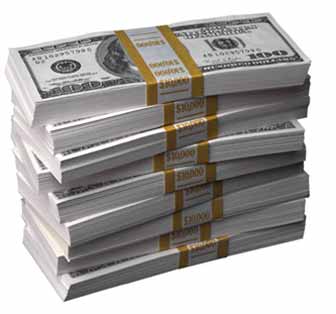Federal law requires a person to report cash transactions of more than $10,000 by filing IRS Form 8300,
Report of Cash Payments Over $10,000 Received in a Trade or Business.
The information on the form helps law enforcement combat money
laundering, tax evasion, drug dealing, terrorist financing and other
criminal activities.
Who is covered
By law, a “person” is an individual, company, corporation,
partnership, association, trust or estate. For example, dealers in
jewelry, furniture, boats, aircraft or automobiles; pawnbrokers;
attorneys; real estate brokers; insurance companies and travel agencies
are among those who typically need to file Form 8300.
Tax-exempt organizations are also “persons” and may need to report
certain transactions. A tax-exempt organization doesn’t have to file
Form 8300 for a charitable cash contribution. Note, however, that under a
separate requirement, a donor often must obtain a written
acknowledgement of the contribution from the organization. See
Publication 526,
Charitable Contributions, for details. But the organization must report
noncharitable cash payments on Form 8300. For example, an exempt
organization that receives more than $10,000 in cash for renting part of
its building must report the transaction.
What’s cash
For Form 8300 reporting, cash includes coins and currency of the
United States or any foreign country. It’s also a cashier’s check
(sometimes called a treasurer’s check or bank check), bank draft,
traveler’s check or money order with a face amount of $10,000 or less
that a person receives for:
- A designated reporting transaction or
- Any transaction in which the person knows the payer is trying to avoid a report.
Note that under a separate reporting requirement, banks and
other financial institutions report cash purchases of cashier’s checks,
treasurer’s checks and/or bank checks, bank drafts, traveler’s checks
and money orders with a face value of more than $10,000 by filing
currency transaction reports.
A designated reporting transaction is the retail sale of tangible
personal property that’s generally suited for personal use, expected to
last at least one year and has a sales price of more than $10,000.
Examples are sales of automobiles, jewelry, mobile homes and furniture.
A designated reporting transaction is also the sale of a collectible,
such as a work of art, rug, antique, metal, stamp or coin. It is also
the sale of travel and entertainment, if the total price of all items
for the same trip or entertainment event is more than $10,000.
Reporting cash payments
A person must file Form 8300 if they receive cash of more than $10,000 from the same payer or agent:
- In one lump sum.
- In two or more related payments within 24 hours. For example, a 24-hour period is 11 a.m. Tuesday to 11 a.m. Wednesday.
- As part of a single transaction or two or more related transactions within 12 months.
Examples of reporting situations
Automobile dealerships
- If a husband and wife purchased two cars at one time from the
same dealer, and the dealer received a total of $10,200 in cash, the
dealer can view the transaction as a single transaction or two related
transactions. Either way, it calls for only one Form 8300.
- A dealership doesn’t file Form 8300 if a customer pays with a
$7,000 wire transfer and a $4,000 cashier check. A wire transfer is not
cash.
- A customer purchases a car for $9,000 cash. Within 12 months, the
customer pays the dealership cash of $1,500 for accessories for that
car. The dealer doesn’t need to file Form 8300, unless they knew or had
reason to know the transactions were connected.
Taxi company
Weekly lease payments in cash from a taxi driver to a taxi company
within 12 months is considered the same transaction. The taxi company
needs to file Form 8300 when the total amount exceeds $10,000. Then, if
the company receives more than $10,000 cash in additional payments from
the driver within 12 months, the company must file another Form 8300.
Landlords
Landlords need to file Form 8300 once they’ve received more than
$10,000 in cash for a lease during the year. But a person not in the
trade or business of managing or leasing real property, such as someone
who leases their vacation home for part of the year, doesn’t need to
report a cash receipt of more than $10,000.
Bail-bonding agent
A bail-bonding agent must file Form 8300 when they receive more than
$10,000 in cash from a person. This applies to payments from persons who
have been arrested or anticipate arrest. The agent needs to file the
form even though they haven’t provided a service when they received the
cash.
Colleges and universities
Colleges and universities must file Form 8300, if they receive more
than $10,000 in cash in one or more transactions within 12 months.
Home builders
Home builders and contractors need to file Form 8300 if they receive
cash of more than $10,000 for building, renovating or remodeling.
When to file Form 8300
A business must file Form 8300 within 15 days after the date the
business received the cash. If a business receives later payments toward
a single transaction or two or more related transactions, the
business should file Form 8300 when the total amount paid exceeds
$10,000.
Each time payments aggregate more than $10,000, the business must file another Form 8300.
How to file
A person can file Form 8300 electronically using the Financial Crimes Enforcement Network’s
BSA E-Filing System. E-filing is free, quick and secure. Filers will receive an electronic acknowledgement of each submission.
Those who prefer to mail Form 8300 can send it to Internal Revenue
Service, Federal Building, P.O. Box 32621, Detroit, MI 48232. Filers
can confirm the IRS received the form by sending it via certified mail
with return receipt requested or calling the Detroit Federal Building at
866-270-0733.
Taxpayer identification number
Form 8300 requires the taxpayer identification number (TIN) of the
person paying with cash. If they refuse to provide it, the business
should inform the person that the IRS may assess a penalty.
If the business is unable to obtain the customer’s TIN, the business
should file Form 8300 anyway. The business needs to include a statement
with Form 8300 that explains why the form doesn’t have a TIN. The
business should keep records showing it requested the customer’s TIN and
give the records to the IRS upon request.
Informing customers about Form 8300 filing
The business must give a customer written notice by Jan. 31 of the
year following the transaction that it filed Form 8300 to report the
customer’s cash transaction.
- The government doesn’t offer a specific format for the customer statement, but it must:
- Be a single statement aggregating the value of the prior year’s transactions,
- Have the name, address and phone number of the person who needs to file the Form 8300 and
- Inform the customer the business is reporting the payment to the IRS.
A business can give a customer who only had one transaction
during the year a copy of the invoice or Form 8300 as notification if it
has the required information. The government doesn’t recommend using a
copy of Form 8300 because of sensitive information on the form, such as
the employer identification number or Social Security number of the
person filing the Form 8300.
A business may voluntarily file Form 8300 to report a suspicious
transaction below $10,000. In this situation, the business doesn’t let
the customer know about the report. The law prohibits a business from
informing a customer that it marked the suspicious transaction box on
the form.
More information:


